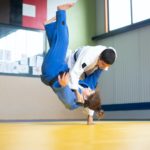The Techniques Of Muay Thai
A majority of the offensive techniques that are used in Muay Thai utilize a student’s hands, feet, elbows, and knees to strike an opponent. In order to bind the opponent for both defensive and offensive reasons, there is a small amount of grappling on the feet that are used – the clinch.
The clinch occurs when someone gets in your circle of radius, inside of your comfort zone. To execute knees and short kicks from the inside, the clinch can be very useful. The Thai fighter makes great use of the clinch, tying up the opponent on the feet and then pounding his stomach, ribs, knees, and legs with brutal knees. Knees are a very popular technique in Muay Thai, as Thai fighters spend a lot of time training their strikes – especially knees and elbows.
Although high kicks to the opponent’s head look amazing during the fights, experienced Thai fighters always say that knees and elbows have a lot more impact, and they do the most damage to the body. If a Thai fighter is very experienced and has enough power in his strikes, he can quickly and easily kill someone with his techniques.
Of all Muay Thai techniques, two, in particular, have become very popular with other styles of martial arts.
The Roundhouse Kick
The roundhouse Thai kick is a very useful technique for both self-defense and competitions, proving to be very efficient when it is executed properly. Thai stylists execute the roundhouse kick by a straight leg and the entire body rotating out from the hip. The hip is locked shortly before the thrown leg makes an impact on the opponent. If executed properly, the roundhouse kick can easily render someone unconscious.
The Low Kick
The low kick is a common Muay Thai attack, that involves a circular movement from the stylist’s body to kick the opponent in his upper shin area. If the low kick isn’t blocked or defended, it can quickly lead to fighting being ended. After a few well-placed low kicks, the opponent will be unable to put pressure on his legs due to the bruising, and will eventually crumble.
With other martial arts styles, such as Tae Kwon Do, stylists use snapping kicks that are indeed faster to execute, although they have less power. Muay Thai on the other hand teaches stylists to follow through with kicks, using the shin instead of the foot. Nearly all of the techniques involved in Muay Thai emphasize movement with the entire body, which means rotating the hip each time the stylist kicks, punches, or blocks. The techniques are slower, although they are far more powerful than techniques found in Tae Kwon Do and even Karate.
As a lot of people already know, the training and conditioning training found in Muay Thai is nothing short of legendary for its intensity and rigorous training. The training in Muay Thai aims to harden the weapons used in martial art to a high degree. Students who have been training in Muay Thai for many years can absorb a beating, yet if they land a shin kick it will feel as if they have just been hit with a sledgehammer.
All in all, Muay Thai is a very dangerous martial art that teaches punishing blows with very little grappling. Thai stylists are physically strong and capable of taking an opponent out with just one well-placed strike. Muay Thai is also one of the most well-known and popular styles in the world today – which is why you shouldn’t hesitate to study it.
DISCLAIMER:
This information is not presented by a medical practitioner and is for educational and informational purposes only. The content is not intended to be a substitute for professional medical advice, diagnosis, or treatment. Always seek the advice of your physician or other qualified healthcare providers with any questions you may have regarding a medical condition. Never disregard professional medical advice or delay in seeking it because of something you have read.
Since natural and/or dietary supplements are not FDA-approved they must be accompanied by a two-part disclaimer on the product label: that the statement has not been evaluated by FDA and that the product is not intended to “diagnose, treat, cure or prevent any disease.”





